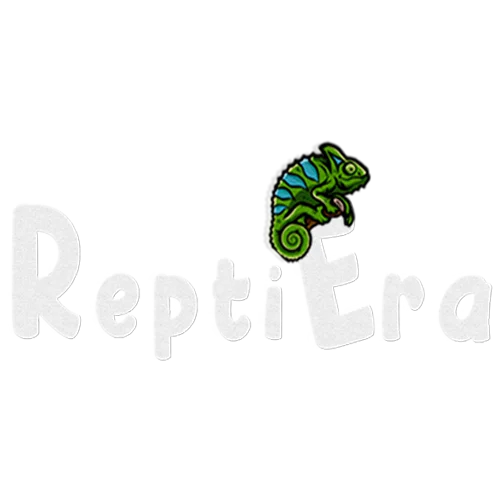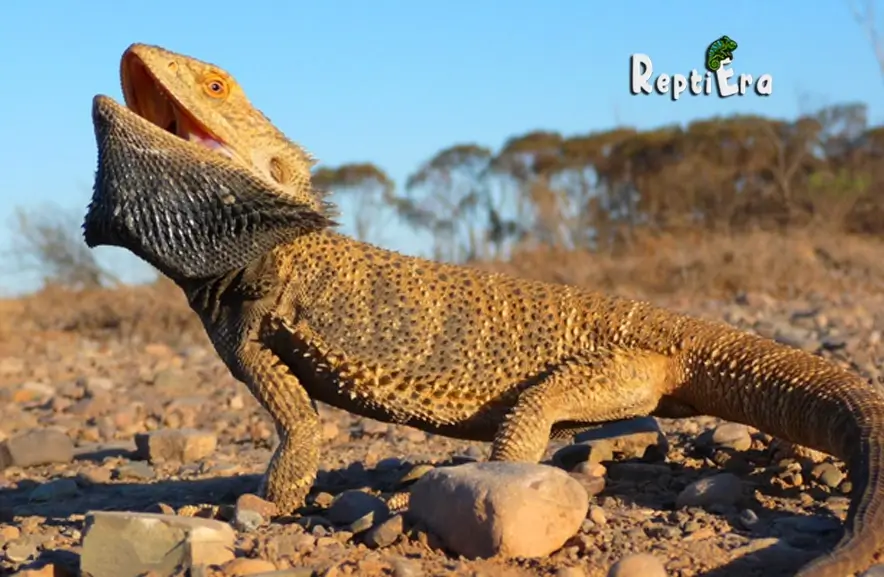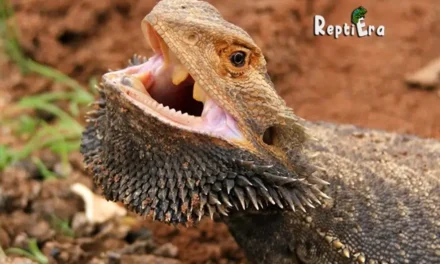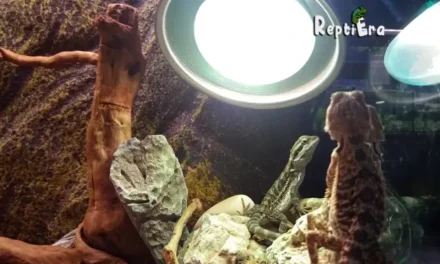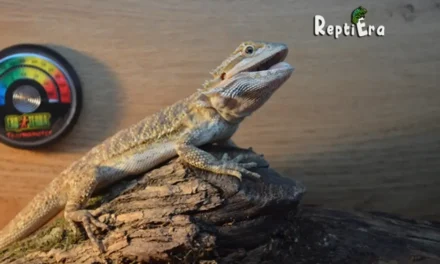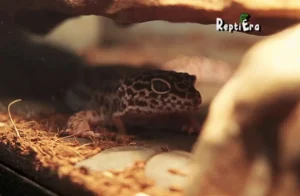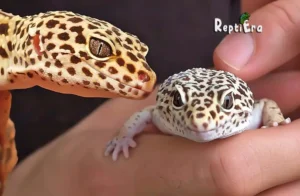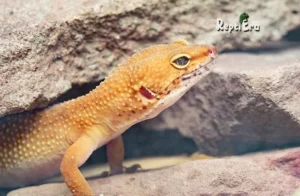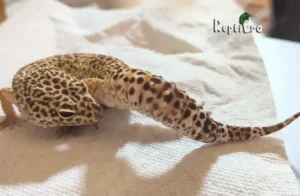As an owner of these pet reptiles, I’ve observed their calm temperament and dragon-like appearance firsthand, often seeing them basking on rocks within their enclosures, embodying the essence of a sedentary lifestyle. Despite being small lizards, their ability to move fast is quite remarkable, contrasting their usual laid-back nature.
How Fast Can A Bearded Dragon Run?
Watching them charge across the room in pursuit of insect prey, cleverly using long tongues to catch their quarry from the corner of their eyes, is a sight to behold. It’s especially surprising when these little lizards, known for their leisurely pace, suddenly sprint, showcasing speeds that can reach up to 9 miles per hour.
This is nearly twice as fast as a Guinea Pig and significantly faster than Ball Pythons, which barely manage a top speed of 2 miles per hour. This swift movement is not just for show; it’s a crucial survival tactic, whether they’re in their natural habitat or the safety of a home enclosure.
Here, we explore the average velocity of Bearded Dragons and contrast it with the pace of other reptiles and common pet animals.
Table of Contents
About the Bearded Dragon
Originating from Australia, bearded dragons are versatile lizards that thrive in diverse locales and habitats, ranging from deserts to forests, rainforests, beaches, and savannahs. They are easily spotted and do not shy away from people, showcasing their active nature during the day.
Known for their peaceful demeanor, they’ve gained popularity as pets around the world, despite it being illegal to export them wild to protect natural wildlife. A significant population of these reptiles is now bred and sold domestically.
They are generally sedentary, less skittish than many other reptiles, and can be easily handled, often coming to the enclosure door when they recognize their owner’s voice to be picked up or fed. Their relaxed nature makes it all the more surprising to owners when they see them sprint at decent speeds, a stark contrast to their usual calm.
How Fast Are Bearded Dragons?
The speed at which a Bearded Dragon can run is influenced by several factors, including its age, general condition, species, and size.
Typically, these reptiles can reach speeds of up to 9 miles per hour, but the actual speed an individual Beardie can reach may vary. The reason for running plays a significant role; whether the dragon is fleeing from a predator or chasing prey, it tends to move quickly. Interestingly, their agility allows them to swiftly move to a different location or water source when needed, showcasing their adaptability in various situations.
Bearded Dragons vs Other Pets
Bearded Dragons are swift among lizards, but how do they stack up against other Animals?
Average running speeds of other reptiles
The typical sprinting paces of various reptiles can differ significantly, influenced by factors such as size, species, and habitat. Here’s a chart offering a comparison of the usual running speeds among diverse reptiles:
| Animal | Speed |
| Python | 1.1 mph |
| Sidewinder | 18 mph |
| Leopard Gecko | 6 mph |
| Bearded Dragon | 9 mph |
| Spiny-Tail Iguana | 22 mph |
| Guinea Pig | 5 mph |
| Rat | 11 mph |
| Komodo Dragon | 12 mph |
| Leatherback Sea Turtle | 22 mph (swimming) |
| Green Iguana | 21 mph |
| Black Mamba Snake | 12 mph |
When comparing Bearded Dragons, known for their speeds up to 9 mph, to other reptiles, a table of average running speeds reveals fascinating contrasts. For instance, the Komodo Dragon and Black Mamba Snake dash at 12 mph, while the Green Iguana can accelerate to 21 mph.
Not to be outdone, the Leatherback Sea Turtle, primarily a swimming creature, glides through water at 22 mph. Among lizards, the Spiny-Tail Iguana stands out as the fastest-recorded lizard, reaching up to 20 miles per hour. In stark contrast, Pythons crawl at a mere 1 mile per hour.
Meanwhile, the Sidewinder Snake impressively slithers at 18 miles per hour, showcasing a diverse range of mobility and agility across the reptilian kingdom, from those sprinting on two legs to those adept in the water.
How bearded dragons measure up
Despite their surprising speed, Bearded Dragons are not known to be the fastest reptiles, but they certainly measure up with some impressive speeds. Their ability to run on two hind legs enhances their agility and swiftness, allowing them to move with remarkable finesse.
This running ability becomes particularly evident when they feel threatened or are in pursuit of prey, showcasing a side to these creatures that contradicts their typically calm demeanor. Although they might not outrun the fastest reptiles, their speed and dexterity in movement certainly make them stand out in the reptilian realm.
The 4 Reasons for Running
Bearded Dragons play the role of both hunter and the hunted, meaning they often sprint to catch or escape other creatures. They run mainly because:
1. Running from Predators
The number one reason an inland bearded dragon might bolt is the threat to its life by a predator, making it a common prey scenario in the Australian desert, their natural habitat. These agamid lizards move quickly to find a hiding spot, sensing danger by detecting the presence of a disturbance or predator, a crucial survival tactic in the food chain where animals like crocodiles, various species of snakes, dingoes, and large birds are the hunters.
This instinct to flee from threats is not just limited to the wild; in captivity, a startled lizard may run off rapidly from its tank if it feels threatened, showing that Beardies, even as pets, retain their instinctual responses. They might avoid interaction by moving in the opposite direction when a stranger approaches their enclosure or during attempts at handling, underscoring their natural inclination to flee rather than hesitate when faced with potential danger.
2. Running After Prey
Another reason for running, both in the wild and in captivity, involves a bearded dragon chasing its prey. Unlike when escaping danger, they don’t run as fast when after food to not expend too much energy they’ll need for later.
Being omnivores, they eat everything from invertebrates like beetles and ants to vegetation. They don’t need to hit their top speed of 9 miles per hour to catch these, but they might speed up to snatch up small lizards and other vertebrates. Their quick movements help them grab nimble prey animals. Their natural food also includes crickets and other jumping insects, so a beardy might chase these for a short time to get a meal.
On the other hand, domesticated bearded dragons readily consume live insects that move at a leisurely pace:
- Worms
- Dubia Roaches
- Feeder Insect
- Vegetation
In the wild: finding the next meal for an animal like the bearded dragon is never a sure thing. Imagine spotting a crunchy cricket some distance away; the bearded dragon might sprint to catch it, especially if it’s hungrier, moving faster and longer to secure its prey. Similarly, in captivity, these creatures get excited and hungry while anticipating their meal.
You might notice them run excitedly towards the plate you just set down, driven by an instinctual urge they can’t help but follow, especially when jumping bugs and plants are involved.
3. Moving Locations
The unforgiving Australian desert landscapes have honed the survival instincts of the bearded dragon.
Upon detecting a shift in weather indicating the need to relocate, they might sprint to reach a new location swiftly.
Some changes in the weather that might make the beardy move quickly to another place include:
- Incoming rain
- Dust storms
- High winds
- Sunset
- Too high or low of a temperature
Bearded Dragons generally prefer to walk from one location to another, but they can sometimes be seen running towards a new location. Whether they run in search of a water source or are simply moving from one spot to another, it’s often a safer option than walking, especially in the wild where they might be considered prey animals.
A Beardie moving quickly can be a common sight, particularly when the motivation is strong enough, showcasing their ability to adapt their speed based on needs.
In a domestic setting, this could occur if the living environment isn’t properly arranged.
If the tank is overly moist, the temperature is off, or there’s a lack of UV light, the reptile might try to flee by running.
4. They’re Running For Their Lives (Literally)
When running away from perceived danger, bearded dragons are literally sprinting for their survival, often confronted by predators like birds, snakes, dingoes, and foxes in the wild. Not known as fighters, these animals rely on their speed, becoming the fastest they can when their lives are at stake.
Another defense mechanism is to play dead, an amazing display of their innate ability to remain still and paralytic under extreme stress. However, when the situation demands, a bearded dragon decides to use its two back legs to flee as fast as possible, showcasing an incredible burst of speed when it matters the most.
Bearded Dragon Speed
Despite not being the most swift of animals in the wild, Bearded Dragons can move quickly when necessary, especially when their life is in danger. They are known to run fastest on their hind legs, taking a bipedal form that allows them to reach speeds of up to nine miles per hour as an adult, equivalent to a 6-minute 40-second mile.
While fast, they cannot maintain this speed for very long, mainly using it to escape from a large predator. In captivity, extreme running is less common due to limited space in their tank, but a domesticated pet might still showcase this behavior when adventuring outside their enclosure or if feeling threatened by a predator like a cat, dog, or even a curious kid. Owners should be used to following them calmly and quickly to ensure they can hide safely if surprised, as such situations can unfold unexpectedly.
TIP: Compared to other animals, a bearded dragon might run slower on all four legs, but when it switches to its two hind legs, it gains a notable advantage in speed. This reptile often adopts this posture when searching for food or attempting to reach a better location, showcasing impressive agility especially when running away from threats.
Can I Let My Bearded Dragon Run Around The House?
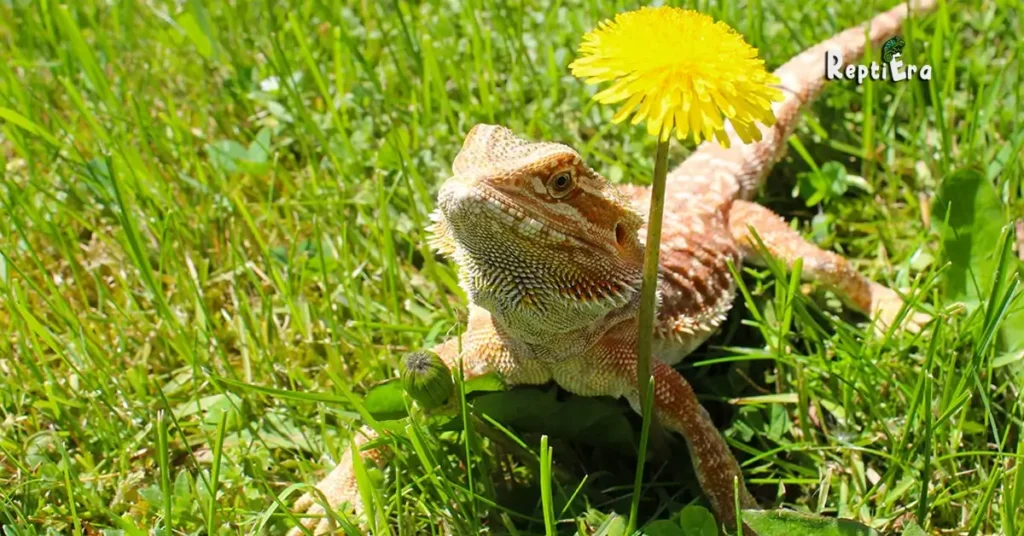
Yes, you can allow your bearded dragon to roam around the house, but it’s crucial to take certain precautions. Exploring a new area can be a delightful way for you and your beardie to bond, as they enjoy and are stimulated by discovering new places and things. Given their fairly quick running ability, ensure to implement extra precautions when letting them out to run and explore safely.
These safety measures consist of the following tips:
- Check out a space that’s enclosed, so they can’t get out.
- Make sure the room is at the right temperature and safe.
- Don’t let other pets in the area.
- Take away anything they might swallow by mistake.
- Only let them explore after they’ve used the bathroom.
- Keep the lighting and noise level steady.
- Pay close attention to your bearded dragon and don’t leave it alone!
- Ensure they can get out of any tight spots they might sneak into.
Taking the right precautions can significantly lessen the chance of a hind leg bolting situation, ensuring a safe and pleasant experience for your pet. It’s advisable to allow this freedom whenever possible, ideally twice a week, to maintain their well-being and happiness.
How Fast Can Your Bearded Dragon Run Around the House?
Things like how big, how old, and how healthy a bearded dragon is can affect how fast it moves.
Factors that affect speed
Lots of factors play a role in a bearded dragon’s running speed. Let’s check them out:
- Type of bearded dragon: Different kinds exist, with some being speedier.
- Age: Young bearded dragons tend to be quicker than the older ones.
- Size: Larger dragons usually move more slowly than the smaller ones.
- Habitat: Wild bearded dragons might be speedier than those living as pets.
- Health: An unwell dragon won’t move as fast, but a fit one can hit speeds up to 9 mph!
- Feeling threatened: A bearded dragon will speed up if it senses danger.
- Space available: To hit their highest speed, dragons need plenty of room.
Speed in captivity vs. in the wild
The top speed of a wild bearded dragon can reach up to 9 miles per hour, similar to that of a captive one, but the opportunities to utilize this speed differ greatly due to the natural environment. In the wild, they have more space to run, often for reasons such as evading predators or chasing prey, enhancing their stamina and agility through daily survival challenges.
This keeps them on their toes, contributing to better muscle tone and overall fitness, leading to an active and challenging lifestyle. Despite this, the actual difference in speed isn’t significantly different between the two, as physical capabilities are inherent; it’s the environment and lifestyle that mainly influence their ability to sprint.
Maximum speed of a bearded dragon
Bearded dragons can run quite fast for their size, with a usual top speed of around 9 miles per hour. However, there have been instances where a record speed of 20.8 miles per hour was achieved, demonstrating their ability to use their speed effectively whether to flee from danger or chase after food.
Factors like fear and hunger can make them move faster, especially when a pet feels scared or spots something tasty. It’s truly surprising how such a small creature can reach these speeds, showcasing their remarkable agility and speed capabilities.
Training Bearded Dragons to Run
Training your bearded dragon to run can be a fun and engaging experience for both you and your pet. Starting in a safe environment with enough space for them to move freely, use treats like insects or veggies to encourage movement. Hold the treat in front of your dragon and then move away slowly, prompting them to follow.
Gradually, they’ll understand that moving towards the treat yields a tasty reward. This exercise serves as great physical activity that not only strengthens your bond but also keeps them interested and eager to learn. Remember to keep training sessions short and positive to maintain their enthusiasm.
Do Bearded Dragons Run On Two Legs?
It’s an interesting fact that bearded dragons can indeed run on their back legs, especially when they need to sprint. A video or example of this can easily showcase their unique locomotion. Various theories suggest this behavior is due to a sudden shift in their center of gravity, allowing them to turn sharply and avoid predators more effectively.
The weight distribution causes their bodies to lift into the air, resembling a wheelie when a beardie races on two legs. This adaptation enables them to move quickly, changing from front to back to escape threats or navigate their environment.
How Fast Can a Bearded Dragon Climb?
Although not natural climbers, Bearded dragons have shown the ability to escape their tank or navigate the wild with surprising agility. Young ones, being semi-arboreal, spend considerable time living in trees to stay safer from predators. Adults lead a more terrestrial life but will climb to bask, hunt, or flee when necessary. There aren’t many studies on their climbing speed, yet they can adeptly scale rocks and vines, hinting at their versatile mobility.
How Fast Can A Bearded Dragon Swim?
While Bearded dragons are decent climbers, they’re considered terrible swimmers. Originating from inland Australia’s dry environments, they seldom encounter bodies of water in the wild, lacking the adaptations typical of an aquatic reptile. However, in a pinch, they can swim, but not well enough to cover long distances, as one might find on a comprehensive list of swimmers.
Are Bearded Dragons Easy To Handle?
Despite their ability to run fast, handling bearded dragons is quite manageable as they are among the most handleable pet reptiles. They are typically relaxed and of perfect size to pick up and hold, contrary to their spiky appearance, they are not prone to biting. Their primary defense is to run away when threatened, but there’s no need to be worried; holding their favorite treats in your hands can make the catch much easier.
How To Avoid A Runaway Beardie
When handling a reptile like a bearded dragon, there’s always a chance it might run away or escape. To prevent this, ensure your bearded dragon is secure within its enclosure and be mindful when taking it into your hands. To catch them safely, keep noise and stimulation to a minimum, and discourage people from walking into the room where you’re hanging out with your pet.
Never grab your dragon from behind as it might get surprised and try to escape. If they’re struggling while you’re holding them, it’s better to let go and guide them back to their habitat rather than risk losing them in the house.
10 Things You Didn’t Know About Bearded Dragons
Bearded dragons are relatively new to the shores of America, but they’ve quickly become one of the cool things pet enthusiasts strongly consider bringing into their lives and homes. There’s a lot you probably didn’t know about these fascinating creatures, from their unique behaviors to their care needs, making them an intriguing addition to any household.
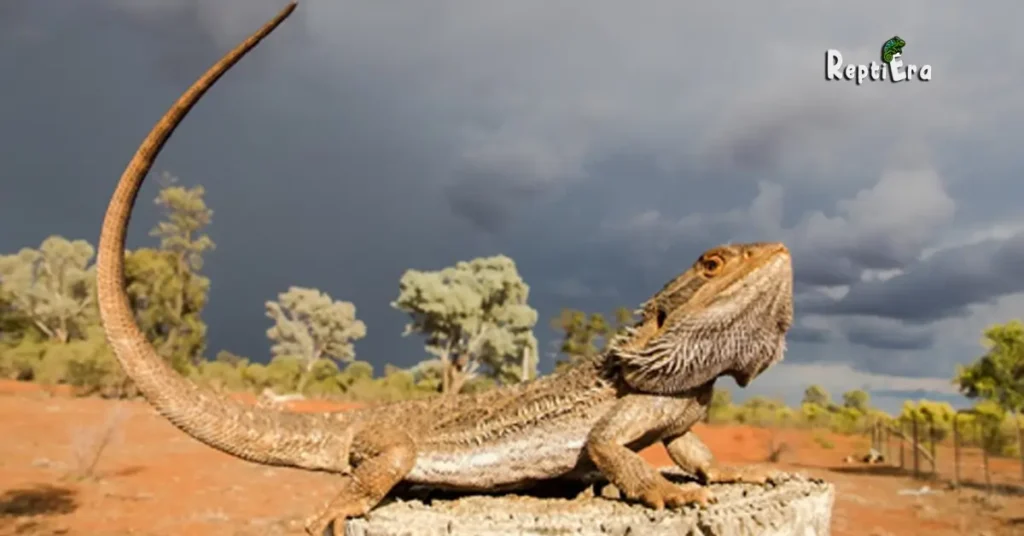
Fact 1
Bearded dragons, known by their scientific genus name Pogona, specifically, the Inland Bearded Dragon, are classified as Pogona vitticeps. They are affectionately referred to by their colloquial name, beardies, by enthusiasts and pet owners alike.
Fact 2
Beardies are known to wave their arms as a form of species recognition or to demonstrate submission. Observing cute-as-pie baby beardies waving is a delightful sight, showcasing their social behaviors and communication methods.
Fact 3
Despite their reputation as sedentary lizards, Bearded dragons can run at speeds of up to nine miles per hour. This surprising capability contrasts with their typically relaxed demeanor in captivity.
Fact 4
Bearded dragons are celebrated in the reptile world for being easy-going and relaxed, making them one of the easiest to leash train. Their docile nature allows owners to casually dress them in clothing, adding a unique charm to their pet care experience.
Fact 5
The name “bearded dragon” comes from the spiny projections under their necks that resemble a man’s beard. When they feel threatened or excited, they puff out their beards and open their mouths to make themselves look bigger, an impressive display of their natural defense mechanisms.
Fact 6
To express romantic interest, bearded dragons engage in a unique behavior of bobbing their heads up and down towards prospective mates. The male performs this action rapidly, while the female typically responds at a slower pace, and they may also wave to further show interest in each other.
Fact 7
Beardies have a diverse diet and eat a variety of foods including greens, leaves, fruit, flowers, and small pieces of meat. Their carnivorous side enjoys insects, small rodents, and even small lizards, showcasing their adaptability in dietary preferences.
Fact 8
Beardies may take naps for a few weeks during the fall, but this can happen at any time of the year. After their rest, they wake up and get back to life as usual, showing their unique adaptation to rest periods.
Fact 9
Captive bearded dragons can live up to ten years, provided they are kept both physically and mentally healthy. Their longevity is a testament to the effective care they receive from dedicated owners
Fact 10
Bearded dragons originate from the deserts of Australia and were introduced to the United States in the 1990s. Since then, they have become increasingly popular as pets, cherished by enthusiasts across the country.
FAQs
Can bearded dragons escape?
If escaped and found outside, the roaming distance of a bearded dragon can vary. Bearded dragons are primarily terrestrial reptiles and are not known to be fast or agile runners, but their curiosity can lead them to explore beyond their usual confines.
How fast can a bearded dragon run in KM?
Bearded dragons can run up to 14.5 km per hour, showcasing their capability for quick bursts of speed when necessary. Despite this, they are mostly sedentary lizards, preferring a more laid-back lifestyle.
Is it cruel to keep bearded dragons?
Keeping reptiles like bearded dragons in a tank in your living room raises ethical considerations. Purchasing them from a store or online could be seen as supporting a cruel industry that may be indifferent to the suffering of animals, suggesting a need for responsible pet ownership and sourcing.
Are bearded dragons lazy pets?
Beardies are not particularly lazy pets; they often enjoy cuddling with their owners while they watch TV, showcasing their cuddly nature. Their increasingly popular status as a pet is partly due to the common misconception that they are easy to take care of.
Conclusion
The exploration of the bearded dragon’s capabilities and characteristics has revealed intriguing aspects of these reptiles, from their surprising speed of up to 14.5 km/h to their adaptability in environments ranging from the arid deserts of Australia to the comfort of a living room. Despite their potential for quick bursts of speed, bearded dragons are primarily sedentary, enjoying the calmness of their habitats and the companionship of their owners.
Their ability to express emotions, from waving for recognition to puffing their beards in defense, along with their dietary diversity and unique behaviors, makes them fascinating pets. However, the ethical considerations of keeping bearded dragons, coupled with the responsibility to provide them with a suitable and enriching environment, underscore the importance of informed and compassionate pet ownership. This article not only sheds light on the physical capabilities of bearded dragons but also invites a deeper appreciation for their complex nature and the care they require.
